
|
Feedback Form
| Introduction | Programming Instructions | Teachers' Section | Looking after your Roamer |
 |
TEACHING THE ROAMER
The Roamer moves forward and back, turns left and right, waits and makes
sounds. You teach the Roamer to do this by pressing keys on the top of
its body. There is a key for each of these functions, and a set of number
keys.
To enter an instruction press a key, followed by a number. This tells the Roamer how far to move, how much to turn, how long to wait or what sound to make.
There are three other function keys: Sense, Two-State Outputs and Stepper Motor.
ROAMER PROGRAMS
There are two types of program, the GO Program
and Procedures.
The GO Program is a list of instructions carried out when you press  .
.
A Procedure is a list of instructions with a name. Once you have defined the list, its name (e.g. P1) is used like any other instruction. When you enter its name in the GO Program, the Roamer will carry out the whole procedure list.
MEMORY
The Roamer has two types of memory, GO Memory
and Procedure Memory.
The Roamer will remember up to 59 instructions, and its powerful programming facilities enable it to carry out hundreds of actions.
When its memory is nearly full the Roamer will sound a warning, similar
to the sound you hear when you press  .
.
GO MEMORY
Instructions in the GO Memory are carried out when you press  . If you add more instructions after executing the GO Program, they will
be added to the GO Program and carried out the next time you press
. If you add more instructions after executing the GO Program, they will
be added to the GO Program and carried out the next time you press  .
.
The Roamer waits for two seconds after you press  before executing the GO Program.
before executing the GO Program.
CLEARING THE GO MEMORY
Pressing 
 clears the GO Memory and allows you to enter a new GO Program. It does
not clear the Procedure Memory.
clears the GO Memory and allows you to enter a new GO Program. It does
not clear the Procedure Memory.
The first time you press  a warning is sounded. Pressing
a warning is sounded. Pressing  a second time clears the GO Memory.
a second time clears the GO Memory.
If you press  by mistake,
press another key, or wait 10 seconds. The Roamer will then carry on with
its GO Memory intact.
by mistake,
press another key, or wait 10 seconds. The Roamer will then carry on with
its GO Memory intact.
DEMONSTRATION PROGRAM
If you press  after you
switch on the Roamer, it will carry out the Demonstration Program. This
can be used to show beginners the basic Roamer functions.
after you
switch on the Roamer, it will carry out the Demonstration Program. This
can be used to show beginners the basic Roamer functions.
| REMEMBER TO CLEAR THE DEMONSTRATION PROGRAM FROM THE GO MEMORY BEFORE PROGRAMMING. |
 FORWARD
AND
FORWARD
AND  BACK
BACK
Pressing  or
or  followed by a number from 1 to 99 tells the Roamer to move forward or
back that number of units. (See UNITS OF DISTANCE AND TURN).
followed by a number from 1 to 99 tells the Roamer to move forward or
back that number of units. (See UNITS OF DISTANCE AND TURN).
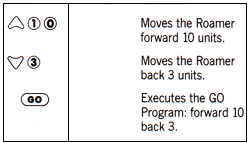
(These examples are illustrated in the style suggested on the programming sheet).
 RIGHT
AND
RIGHT
AND  LEFT TURN
LEFT TURN
Pressing  or
or  followed by a number up to 999 turns the Roamer to the right (clockwise)
or left (anticlockwise) that number of units. (See UNITS OF DISTANCE
AND TURN).
followed by a number up to 999 turns the Roamer to the right (clockwise)
or left (anticlockwise) that number of units. (See UNITS OF DISTANCE
AND TURN).
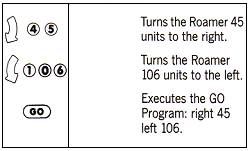
 WAIT
WAIT
Pressing  followed by a
number from 1 to 99 tells the Roamer to be still and quiet for that number
of seconds.
followed by a
number from 1 to 99 tells the Roamer to be still and quiet for that number
of seconds.
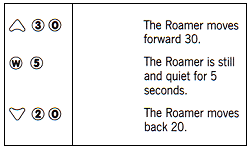
 SOUND
SOUND
The Roamer has a programmable sound facility. You need to specify how
long each note will last (duration) and how high or low the note will
be (pitch).
To play a note, press  followed
by a number from 1 to 8 for its duration, and another number from 1 to
13 for its pitch.
followed
by a number from 1 to 8 for its duration, and another number from 1 to
13 for its pitch.
If you want a rest (silent note), enter 14 for the pitch.
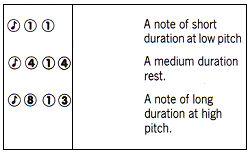
UNITS OF DISTANCE AND TURN
When you switch the Roamer on it moves forward and back in units equal
to its body length (30cm) and turns in angular units of 1 degree. You
can change the units of distance and turn. This allows the teacher to
set the most appropriate units for each teaching period.
Once the units are set, they remain unchanged until you redefine them, or switch the Roamer off. Clearing the GO Memory does not change the last unit setting.
To clarify which bracket opens and closes a list, [ and ] have been used
instead of 
Changing the Units of Distance
To change the unit of distance, press  or
or  followed by
followed by 
Then press a number between 1 and 99. The number determines how many centimetres will be in each unit of distance.
Then press  again.
again.
The GO Program must be run before the change becomes effective.
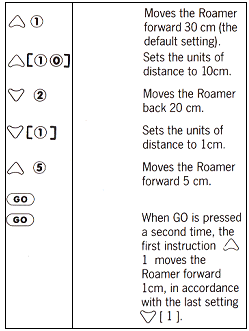
Changing Units of Turn
To change the unit of turn, press  or
or  followed by
followed by 
Then press a number from 1 and 999. This number determines how many degrees will be in each unit of turn.
Then press  again.
again.
The GO Program must be run before the change becomes effective.
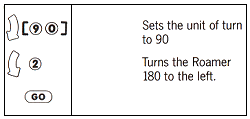
Changing the tempo and octave
Roamer sounds may be played at one of five tempos and one of three octaves.
To change tempo or octave press  then
then 
Press a number between 1 and 5 for the tempo. 1 is fastest, 5 is slowest.
Press a number between 1 and 3 for the octave. 1 is lowest and 3 is highest.
Press  again.
again.
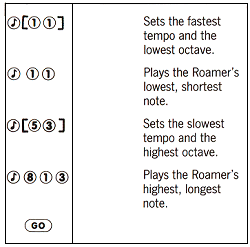
When you press  , the
Roamer starts with the tempo set at 3 and the octave set at 2.
, the
Roamer starts with the tempo set at 3 and the octave set at 2.
|
 |
 |
|
SOUND CUES
When you press a key, the Roamer makes a sound. If the instruction is
valid the sound is positive. Invalid instructions produce a negative sound.
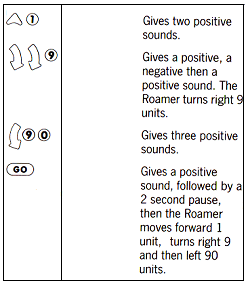
STOPPING THE ROAMER
If the Roamer is carrying out a list of instructions and you want to stop
it before it has finished, hold down any key until it completes the current
instruction. This feature allows the children to stop the Roamer if it
is not doing what they wanted it to do.
 CANCEL
ENTRY
CANCEL
ENTRY
Pressing  cancels the last
instruction or part instruction from the GO Program.
cancels the last
instruction or part instruction from the GO Program.
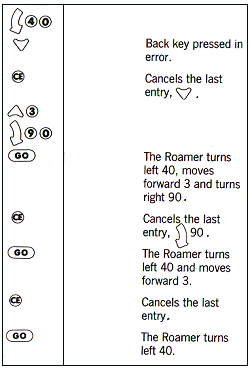
 REPEAT
REPEAT
Pressing  , followed by
a number up to 99, will make the Roamer repeat a following list of instructions,
that number of times. The list must be enclosed in a "box" by placing
, followed by
a number up to 99, will make the Roamer repeat a following list of instructions,
that number of times. The list must be enclosed in a "box" by placing
 before and after the list.
before and after the list.
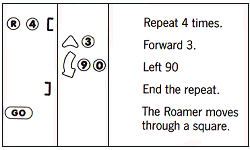
Repeat lists can contain other repeat lists. This is like putting one box inside another. You can place up to five "boxes" within "boxes" i.e., nest repeats 5 deep.
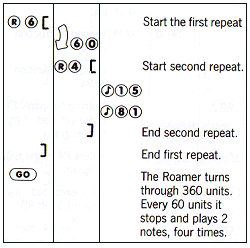
This program has a nest of repeats 2 deep.
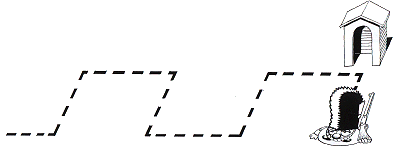
PROCEDURES
A procedure is a list of instructions named P, plus a number from 1 to
99. The list is enclosed in brackets  .
.
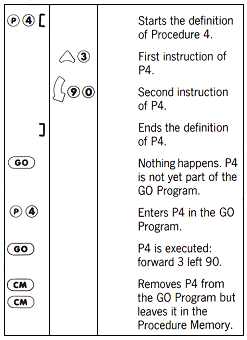
When keying in instructions in a procedure definition, sound cues for valid and invalid instructions are still made. However a different pitch is used to inform the programmer that the instructions are part of a procedure, not part of a GO Program.
Putting a Procedure Inside Another Procedure
A procedure can be part of another procedure.
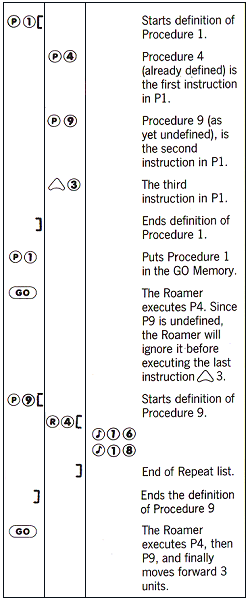
Procedures can be nested to any depth - memory permitting.
CHANGING A PROCEDURE
To change a procedure, simply redefine it.
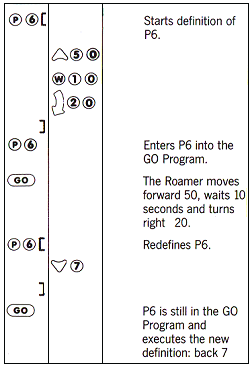
Erasing a Procedure
To erase a procedure from the Procedure Memory, enter  and the procedure number, followed by
and the procedure number, followed by  and
and 
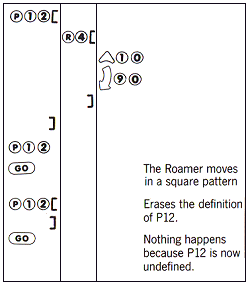

RULES ABOUT USING PROCEDURES
1. A procedure cannot use itself
Roamer procedures are not recursive.

2. You can define only one procedure at a time
3. A procedure cannot include a procedure with a lower number
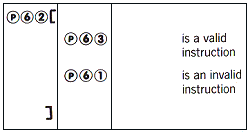
This means that Procedure 1 can call all other procedures, and Procedure 99 cannot call any.